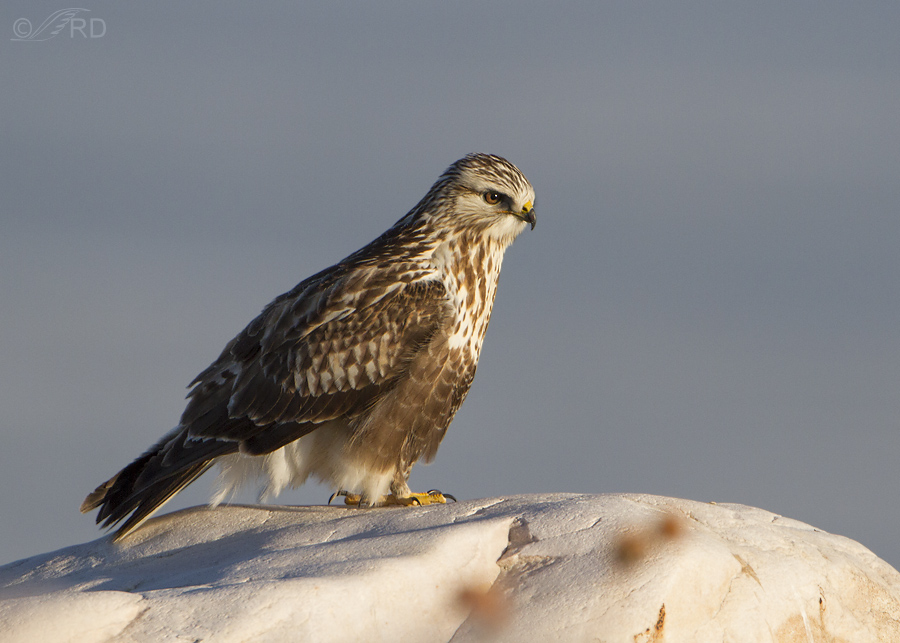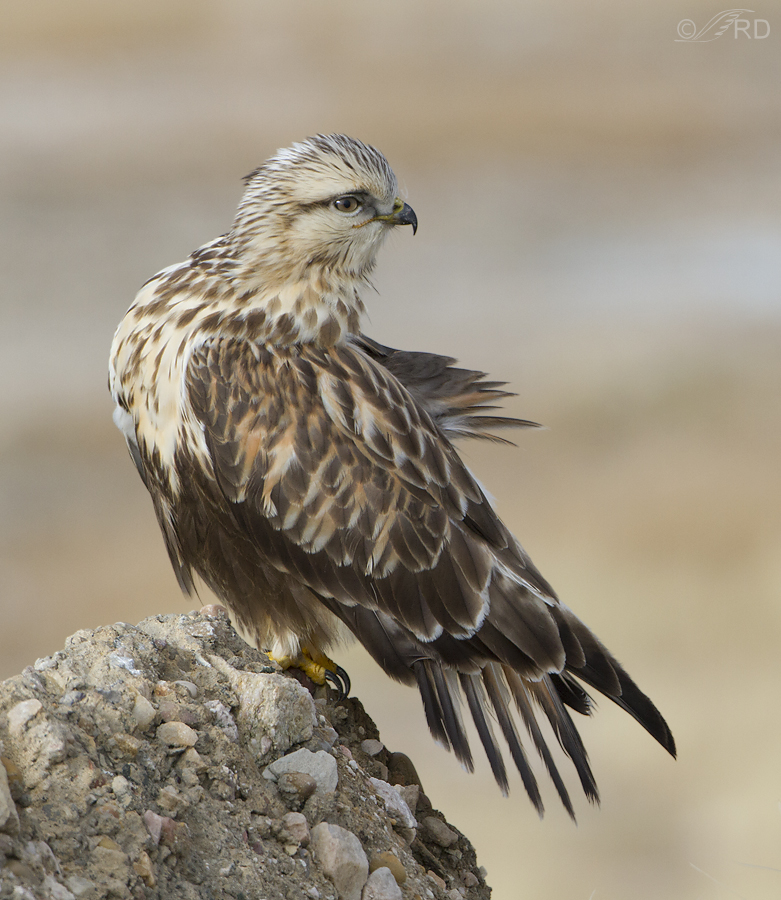Rough-legged Hawks are a true arctic species, spending about 7 months of the year on their breeding grounds in the arctic or sub-arctic tundra or taiga of Alaska or Canada. Then they migrate south and winter in most of the lower 48 states, with the exception of the SE region and parts of California and Arizona.
I love it when they’re here as I find them to be exceedingly handsome birds and I really enjoy photographing them. And yes, I’m already looking forward to their return. Every time I’m in their favorite haunts I can’t help looking for them on some of their preferred perches, even this time of year. So, feeling a little nostalgic for them on a Saturday night, I thought I’d do a post on the species.

1/2000, f/6.3, ISO 500, 500 f/4, 1.4 tc, natural light, not baited, set up or called in
Normally I’m not terribly fond of the Tintic Quartzite rocks on Antelope Island as perches because they’re so bright that they tend to blow out the whites but as you can see by the shadows the sun was still very low when this shot was taken so I got pretty good detail on most of the perch. And besides, I like the rounded, weathered look of this particular boulder. I do wish the out of focus sunflower heads in the foreground weren’t there but for me they’re not an image killer.

1/2000, f/7.1, ISO 500, 500 f/4, 1.4 tc, natural light, not baited, set up or called in
This is one of the few shots I have of the species in full flight, vs just after takeoff, (as you can tell from the position of the feet) with a background other than sky.

1/1000, f/8, ISO 400, 500 f/4, natural light, not baited, set up or called in
This hawk was one of the most cooperative raptors I ever photographed. It posed for me for what seemed like forever – in fact I had to leave the bird, still in place and posing, in order to be on time for a lunch date. That’s not something I would normally ever do, but the lunch appointment was with a very good friend.
In checking all of my images of this species (not easy to do, they’re spread out over 3 computers and 7 years), the earliest in the winter I’ve seen roughies arrive has been November 3 and they’re all normally gone from northern Utah by March 1 – with one notable exception. Last spring we had several birds stay late and I actually photographed one on May 8. Almost unheard of.
Yes, I certainly do look forward to seeing and photographing roughies once again – only a few weeks to go…
Ron


Incredibly beautiful! What a wonderful series! I had a difficult time picking out the seeds. I actually thought at first they were simply markings on the quartzitite.
Great news Ron,
Mike is absolutely correct save one fact, I was not the one to notice our first Buteo lagopus of the season at the Goshutes. It was my associate Steve, but rest assured if I had been looking east, I would have seen it myself. When I caught it in my binoculars, several loud exclamations of joy escaped my lips, undoubtedly frightening the visitors that surrounded me. As it appeared at a distant, the bird looked like a juvenile. It travelled west and to the north, unmistakably disinterested in continuing south. So, as it stands on Oct. 6th, a Rough-legged seems to have reached it’s destination in the area around Wendover, NV. I would keep my eye out in your next outing to Antelope Island. You may find an early bird already arrived. I certainly hope you do, and cannot wait to see the pictures that are the fruit of the experience.
Well, whoever noticed that bird first I’m delighted to hear of its arrival, Bryce. I’m headed to the island this morning and I’ll certainly be watching for our first arrival out there. We spotted a Swainson’s on the island a couple of days ago – seems to me that bird is pretty late to leave.
Hi Ron, I haven’t had access to the Internet lately, but look forward to catching up with your posts soon. Kind of like you and Roughies. Just last evening Bryce called out our first RLHA of the season, soaring alone in the sunset.
Hey Mike, I’ve been wondering how you’ve been doing up there on the mountain, though I did get a bit of an update from Jerry Liguori about a week ago. Glad to hear that a few RLHA’s are beginning to show up.
Thank you, Ron. These are wonderful images of one of my favorite species. It will be a few weeks before they arrive here (southern OR), but I will begin looking in earnest very soon. Maybe I can conjure one up. On my hawk-watching outings, I always tell folks that Rough-legged’s get the prize for having travelled farthest to attend our party…
What beautiful birds. I can see why you look forward to seeing and photographing. This may sound corny, but to me, they have a certain look of peaceful innocence and serenity.
I suspect I would have been a tad late to lunch – good friend or not. The photograph of the bird in flight took my breath away, and the preening shots were incredible. Thank you so much.
I had a lot of trouble getting into this post, it scared me. I look forward to your birds so much and I would be bereft without them.
Thanks Elephant’s Child. Your comment about having difficulty opening the post concerns me. WordPress as had a few hiccups recently. Please let me know if the problem continues for you (or anyone else).
Very interesting photos, Ron. Photographing a raptor intent on posing for you, then having lunch with a good friend. I guess it doesn’t get much better than that.
It was a good morning Dwynn, a great friend and a great bird.
I was looking forward to my FOS rough-legged hawk anyway, and your gorgeous photos have sharpened that anticipation. MT has recorded it’s FOS rough-legged hawk already but I haven’t had my first of fall yet. Beautiful work, as always!
Thanks very much Katie – I’m very happy to learn that at least one of them has made it past the 49th parallel this early in the season. I’m drooling already…